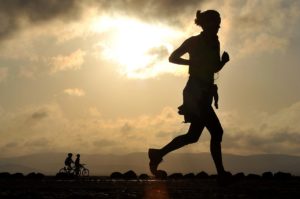- Calls to this hotline are currently being directed to Within Health, Fay or Eating Disorder Solutions
- Representatives are standing by 24/7 to help answer your questions
- All calls are confidential and HIPAA compliant
- There is no obligation or cost to call
- Eating Disorder Hope does not receive any commissions or fees dependent upon which provider you select
- Additional treatment providers are located on our directory or samhsa.gov
Eating Disorders in Young Athletes

image credit: White Water Magazine
Eating disorders are characterized by a disturbance in eating or eating related behaviors that clinically impairs physical health and/or psychosocial functioning. The categories of eating disorders are Anorexia Nervosa (AN) which is characterized by persistent calorie restriction, fear of gaining weight or becoming fat, and a disturbance in perceived body size and shape.
Bulimia Nervosa (BN), is characterized as a recurrent binge eating, more than normal in a two hour period, and inappropriate compensating behaviors to prevent weight gain. This can be through vomiting, laxatives, or over exercise behaviors. Binge eating disorder is characterized as episodes of binge eating without any compensating behaviors, but does have psychological distress.
Eating Disorders and Athletes
Eating disorders can occur across all sports, but not equally amoung sports. Typically more females than males have eating disorders, due to the focus on lean, thin, or low weight body shapes to perform at a higher rate. This thought is believed to have a biochemical advantage in performance, but typically it creates a serious health risk and decreased performance rate in the sport of choice [1].
Eating Disorders in young athletes can increase higher levels of stress than their non athlete peers due to dealing with various pressures of academic achievement, social status, and sport. Athletes, especially female, will often turn to food to control and manage stressors.
Within the sport culture the focus is on reducing body weight and/or fat to enhance sport performance. Other factors that can exacerbate an eating disorder are the individuals team perception and coaches perception around body, weight, and performance. Uniforms can increase body awareness and dissatisfaction, also aiding in eating disorder behaviors [1, 2].
In a study, conducted by the National Eating Disorder Association, 20% of 1,002 male and female college students admitted to personally struggling with an eating disorder, and 40% reported knowing someone who purges [4]. A similar study of 170 female student athletes, from age 13-18 at 6 Souther California high schools reported that 18% experienced disorder eating [4].
Impact of Eating Disorders on Female Athletes
Many females within a sport, typically have two views of self. One is their body defined within the sport, and the second is that of the general population. Coaches can influence the athlete’s behavior through either low support/high conflict environment, or an ego/performance centered motivational environment [1].
Within the team environment, low weight or restrictive eating may be a cultural norm and seen as a good athlete trait. Personality traits common to most successful athletes is perfectionism and high tolerance to pain. Fear of failure and the need to please are also characteristics, all which can lead to eating disorder behaviors and diagnosis [1, 3].
The Female Triad, is a description of three interrelated health concerns with female athletes. This is low energy availability, menstrual cessation, and osteoporosis. Sport culture and pressure for females to achieve or maintain unrealistic low weight can trigger one or all of these factors, which in turn can decrease physical performance [3]. In teens and children this can affect growth, puberty, and brain development.
Factors Influencing Eating Disorder Development
When looking at the healthy weight and nutritional intake for an athlete, they typically will fall between the 25th and 75th percentiles for weight and high for age, as recommended by the National center for Health Statistics. Some athletes will weigh outside this range due to increased muscle mass, and muscle weighing more than fat. Body Mass Index (BMI) measurement is not recommended and has been unfounded recently to provide no relevant information in a person’s health [6].
Many sports emphasize the need for thinness and its link to higher performance within sport. Most typically this is seen in gymnastics, figure skating, running, and swimming [2]. In a study conducted by the National Collegiate Athletic Association, athletes reported that 33% of female athletes have symptoms and attitudes that are at high risk for eating disorders [2].
Behaviors include preoccupation with food, excessive fasting, binging, purging, fear of being overweight or fat, compulsive exercise (even outside of sport practice and games), and continuing to train when injured [2]. At the college level there are more fail safes for athletes struggling with an eating disorder.
Athletes have athletic trainers, physicians, physicals, and coaches that are more focused on health issues due to many students being on athletic scholarships. At the high school level, it is more difficult to identify due to the fact that most schools have a nurse, and a coach.
Athletes have physicals, but through their primary care physician [4]. 10-15% of high school boys who participate in weight-sensitive sports, practice unhealthy weight-loss behaviors, such as dehydration practices or overexercise [6]. Females tend to use food restriction, vomiting, laxative and diuretic use are common in those who are involved in figure skating, gymnastics, diving, running, rowing, and swimming [6].
Athletes competing in weight-dependant sports, such as boxing, weightlifting, and wrestling, show higher rates of compensatory behaviors to influence weight. The most common compensatory behavior reported by athletes is dehydration [5]. and athletes compete in sports that are non-weight dependant are typically female athletes and have higher negative affect [5].
Typically cognitive behavio ral therapies and dialectical behavioral therapy work to manage and regulate health coping skills and emotions. Nutritional counseling and group therapy are highly beneficial in the recovery process.
ral therapies and dialectical behavioral therapy work to manage and regulate health coping skills and emotions. Nutritional counseling and group therapy are highly beneficial in the recovery process.
A special consideration to treating athletes though, is having a treatment team that understands and will work with the athletes sport, providing education and awareness and in sport therapy. Getting athletes to treatment is difficult in the fact that many athletes feel that they will gain weight, or underperform in their sport. Many may resist having an eating disorder due to fear of losing play time or being removed from their sport altogether.
Another barrier to treatment is that the athlete fears that the professional will not understand the importance of sport in their life. It can be helpful to also provide support for the coach and team on awareness and education of eating disorders and it symptomatology.
Coach perceptions around body, weight, size, and shape can either positively or negatively impact the team, especially those with eating disorders. It is important to provide assistance and awareness to help the individual’s support network understand eating disorders [2].
Community Discussion – Share Your Thoughts Here!
What characteristics or behaviors do you see in young athletes? Do you feel thinness and lean body types enhance performance in athletes?
 About the Author: Libby Lyons, MSW, LCSW, CEDS is a specialist in the eating disorder field. Libby has been treating eating disorders for 10 years within the St. Louis area, and enjoys working with individuals of all ages.
About the Author: Libby Lyons, MSW, LCSW, CEDS is a specialist in the eating disorder field. Libby has been treating eating disorders for 10 years within the St. Louis area, and enjoys working with individuals of all ages.
References:
[1]: http://www.ncaa.org/health-and-safety/sport-science-institute/mind-body-and-sport-eating-disorders[2]: http://www.bulimia.com/topics/athletes/
[3]: http://www.athleticbusiness.com/High-School/eating-disorders-and-high-school-student-athletes.html
[4]: http://thesportjournal.org/article/title-female-athletes-and-eating-disorders/
[5]: Eating Disorder Pathology in Elite Adolescent Athletes. International Journal of Eating Disorders, vol. 49, issue 6, p. 553-562. Giel, Hermann-Werner, Mayer, Diehl, Schneider, Thiel, & Zipfel. (2016).
https://www.emilyprogram.com/blog/words-with-wisniewski-research-review
[6]: http://pediatrics.aappublications.org/content/116/6/1557
The opinions and views of our guest contributors are shared to provide a broad perspective of eating disorders. These are not necessarily the views of Eating Disorder Hope, but an effort to offer discussion of various issues by different concerned individuals.
We at Eating Disorder Hope understand that eating disorders result from a combination of environmental and genetic factors. If you or a loved one are suffering from an eating disorder, please know that there is hope for you, and seek immediate professional help.
Last Updated & Reviewed By: Jacquelyn Ekern, MS, LPC on January 3, 2017.
Published on EatingDisorderHope.com

The EatingDisorderHope.com editorial team comprises experienced writers, editors, and medical reviewers specializing in eating disorders, treatment, and mental and behavioral health.

